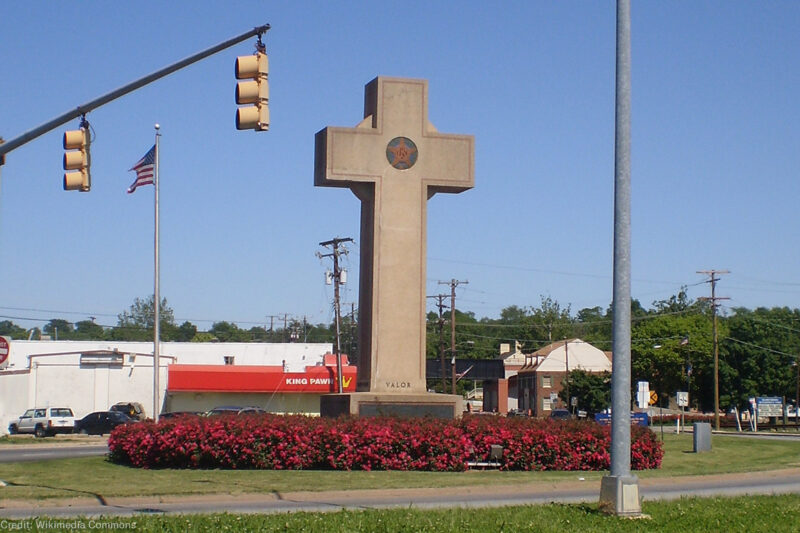The Supreme Court Will Decide Whether the Government Can Display a 40-Foot Latin Cross


Last Friday, the Supreme Court announced that it will decide whether a governmental display of a gigantic, 40-foot Latin cross as a war memorial in Bladensburg, Maryland, violates the separation of church and state.
On the surface, the case appears to be about one religious monument located at one busy intersection in one town but the stakes are, in fact, much higher. A Supreme Court decision upholding the Bladensburg cross could upend nearly 50 years of First Amendment law and risk further marginalizing religious minorities who are already facing growing bigotry, discrimination, and violence.
In the wake of last year’s Muslim ban ruling, many have come to question the Supreme Court’s fidelity to a core First Amendment principle — official religious neutrality. The First Amendment promises equality and liberty for all people, regardless of faith. That promise is carried out, in part, by the Establishment Clause, which requires the government to remain impartial when it comes to matters of religion.
The Constitution’s framers bore witness to the discord and even violence that occurs when the government singles out one religion for disfavor or gives preference to one faith or to religion generally. They sought to avoid that divisiveness by laying the foundation for a robust wall of separation between church and state.
In effectively ignoring the anti-Muslim bigotry at the heart of President Trump’s executive order, the Supreme Court tarnished these principles. The decision to hear Maryland-National Capital Park and Planning Commission v. American Humanist Association could present a timely and desperately needed opportunity for the court to recommit to the religious-freedom ideals enshrined in the First Amendment. Or it could be just the chance longtime opponents of the separation of church and state have been waiting for: an opportunity to strike another serious blow against the constitutional rules that have long curbed the government’s power to signal approval of one religious denomination over others.
The Maryland-National Capital Park and Planning Commission, a governmental entity that took over ownership and management of the Bladensburg cross in 1961, maintains that the cross was intended to honor the sacrifice made by soldiers of every faith who fought in World War I. It is simply, according to the state, an homage to the rows of white crosses that memorialize the American dead at Flanders Field in Belgium or at Suresnes or Belleau Wood in France.
But even if this were true, it tells only part of the story. The graves of Jewish soldiers in those cemeteries overseas “are marked with the Star of David, not a Christian cross,” as one group of Jewish war veterans previously explained to the Supreme Court. And some of those who served and died during World War I were surely Muslim. American Muslims have served honorably in every war from the American Revolution to today.
These details will be glossed over in service of the commission’s argument that the display of a 40-foot Latin cross is secular. Nonsense. The cross is the preeminent symbol of Christianity. Its display by the government sends the unmistakable message that Christians are officially favored and that non-Christians are second-class citizens who don’t belong.
As religion-law scholar Douglas Laycock put it, writing in another case on behalf of Muslim American veterans: “If government can sponsor a Christian cross and deny that it has done anything religious, then words and symbols have no meaning and the Court has consigned the Establishment Clause to the world of Alice in Wonderland.”
That’s exactly what some advocates are hoping will happen, however. The Supreme Court has long made clear that the Establishment Clause prohibits government from acting in a way that has the purpose or effect of advancing or endorsing religion, including by sponsoring an official display that promotes one particular faith. These constitutional rules recognize that, when it comes to protecting and maximizing religious freedom, words and symbols do matter.
Even if no one is formally coerced into religious exercise, when government promotes a religious message, it improperly ties religious beliefs to political standing. Those who follow the promoted faith are favored; those who don’t — well, we’ve seen what happens to them.
Critics of these rules will urge the court to use the Bladensburg cross case to overturn or nullify them. If that happens, it will open the door for government officials across the country to erect religious displays that promote the majority faith and send the message that religious minorities are not welcome in their communities.
No matter how you spin it, the government’s display of a 40-foot Latin cross promotes Christianity. It has the effect of denigrating non-Christians and plays into the hands of those who are prejudiced against them. A Supreme Court ruling that permits the state government to continue sponsoring the Bladensburg cross would unwisely turn its back on our most treasured and enduring religious-freedom principles.
We hope the court does not repeat its mistakes of last term and affirms the lower court’s decision, which held that the cross display unconstitutionally “endorses Christianity -- not only above all other faiths, but also to their exclusion.”
CORRECTION: The original version of this article reported that the cross is maintained and displayed by the state of Maryland. The cross, however, is maintained by a bi-county commission called the Maryland-National Capital Park and Planning Commission. The text has been changed to reflect that fact.

